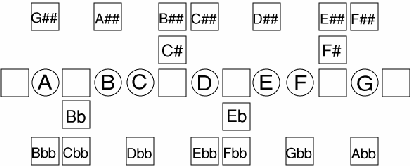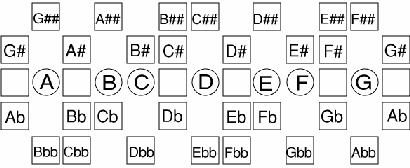Surprise! It's More Than A Bakers Dozen.
Bakers are sweet, they give us 13 instead of 12. Music is even sweeter, it gives us 35 Letter Names for
a dozen pitches! Let's look at this more closely.
There are 7 letters in music and each of these letters has a pitch. Therefore, music may be seen as letters and heard as pitches. The 7 "natural" pitches (letters) of music are: A B C D E F G. Natural means: "not chromatic" . In other words, not sharp (#) and not flat. An Interval is the distance between pitches. The guitar may be thought of simply as 6 strings and 12 frets that repeat themselves in the second octave. An Octave is two sounds of the same letter 12 frets apart.In other words, there are 12 pitches (12 frets) "in-between" the octave. Each of these pitches (frets) may be given a letter name. Let's illustrate the 7 natural pitches as letters.

An Interval is the distance between letters or pitches. Unison is two sounds with the same letter and the same pitch. For example, E on the 5th fret of the 2nd string has the same pitch as E on the 1st string at the "zero fret" (also known as the nut or open). These two E's are in unison - they sound the same. The Guitar may be simply thought of as 6 strings and 12 frets that repeat themselves in the second octave. An Octave is two sounds with the same letter, but not the same pitch. Said another way, an octave is the same letter 12 frets apart. For example, E at the zero fret of the 1st string and E at the 12th fret of the 1st string have the same letter, but one sounds high in pitch while the other sounds low. Now, the 12 frets (12 pitches) of the octave may be given letter names. Consider the following.
There are 5 "chromatic" pitches that fit "in-between" the 7 natural pitches. Chromatic means: "by half-step". One half-step is one fret. Sharp (#) means one half-step (one fret) higher in pitch from any natural letter or pitch. For example, D is on the 3rd fret of the 2nd string, therefore D# is on the 4th fret. Flat (b) means one half-step (one fret) lower in pitch from any natural letter or pitch. For example, E is on the 5th fret of the 2nd string, therefore Eb is on the 4th fret. In these examples, D# and Eb are on the same string and fret and therefore they sound the same, this is called "Enharmonic". Enharmonic means "Two sounds of the same pitch, but not the same letter". So even though there are only 5 chromatic pitches in-between the 7 natural pitches, there are 10 different sharp and flat letter names.

In addition to the five in-between chromatic pitches, 4 of the natural letters (pitches) also have enharmonic chromatic names. For example, F is enharmonic E#, E sounds like Fb, C has the same pitch as B#, and B is enharmonic with Cb.

Now we know 7 chromatic pitches with 14 different chromatic letter names.

Not only may the 7 natural pitches and letters be chromatic (sharp and flat), but they may also be "double-chromatic". Double-Chromatic means "double sharp or double flat". In other words, two frets (two half-steps) higher or lower in pitch from any natural letter or pitch. Two half-steps (two frets) is also know as "one whole-step". Double Sharp (##) raises any natural letter or pitch two frets (two half-steps) higher. For example, D double sharp (D##) is enharmonic with E natural, they have the same pitch. Double Flat (bb) lowers the pitch of any natural letter or pitch two frets. For example, E double flat (Ebb) is enharmonic with D natural, they sound the same. Note: "traditional music theory" uses an "x" as the double sharp symbol, not two sharps (##). For example, F double sharp (F##) is written "Fx". Don't ask me why! Anyway, now we know 7 double-chromatic pitches with 14 different double-chromatic letter names.

Well, there you have it - 35 different letter names for 12 pitches: 7 natural pitches with 7 natural letter names + 7 chromatic pitches with 14 chromatic letter names + 7 double-chromatic pitches with 14 double-chromatic letter names = 35 chromatic letter names!

And now that "35 letter names" is as easy as pie - or as one of my students emailed: it's a "peace" of cake - play and have fun...How sweet it is!
GRAMMY nominated Music Educator Mike Overly easily combines the worlds of deeply-rooted academic study with a well-textured performance resume. His pathbreaking 12 Tone Music Publishing products, including the newly released Tone NoteŽ Music Method for Guitar, provide valuable illuminating insights while simplifying the learning process. Join Mike at www.12tonemusic.com to explore and expand your knowledge of these two iconic instruments through a variety of reviews and interviews, tips and tricks and free lessons of remarkable originality, all presented in a family-friendly forum. Plus, as an added bonus, you get to follow Mr. Pick as he introduces you to fun fretboard games, jokes, riddles, quotes and more. Be sure to read the 12 Tone Music Blog where Mike offers a behind-the-scenes look at the development of his unique approach to solving the problems of modern musical notation and traditional guitar and bass methods. Mike Overly's unmatched perspective on fretboard education has something for everyone ~ from the amateur hobbyist to the serious professional player ~ as well as any music enthusiast who wants to come along for the ride.
Return to Advanced Lessons
There are 7 letters in music and each of these letters has a pitch. Therefore, music may be seen as letters and heard as pitches. The 7 "natural" pitches (letters) of music are: A B C D E F G. Natural means: "not chromatic" . In other words, not sharp (#) and not flat. An Interval is the distance between pitches. The guitar may be thought of simply as 6 strings and 12 frets that repeat themselves in the second octave. An Octave is two sounds of the same letter 12 frets apart.In other words, there are 12 pitches (12 frets) "in-between" the octave. Each of these pitches (frets) may be given a letter name. Let's illustrate the 7 natural pitches as letters.

An Interval is the distance between letters or pitches. Unison is two sounds with the same letter and the same pitch. For example, E on the 5th fret of the 2nd string has the same pitch as E on the 1st string at the "zero fret" (also known as the nut or open). These two E's are in unison - they sound the same. The Guitar may be simply thought of as 6 strings and 12 frets that repeat themselves in the second octave. An Octave is two sounds with the same letter, but not the same pitch. Said another way, an octave is the same letter 12 frets apart. For example, E at the zero fret of the 1st string and E at the 12th fret of the 1st string have the same letter, but one sounds high in pitch while the other sounds low. Now, the 12 frets (12 pitches) of the octave may be given letter names. Consider the following.
There are 5 "chromatic" pitches that fit "in-between" the 7 natural pitches. Chromatic means: "by half-step". One half-step is one fret. Sharp (#) means one half-step (one fret) higher in pitch from any natural letter or pitch. For example, D is on the 3rd fret of the 2nd string, therefore D# is on the 4th fret. Flat (b) means one half-step (one fret) lower in pitch from any natural letter or pitch. For example, E is on the 5th fret of the 2nd string, therefore Eb is on the 4th fret. In these examples, D# and Eb are on the same string and fret and therefore they sound the same, this is called "Enharmonic". Enharmonic means "Two sounds of the same pitch, but not the same letter". So even though there are only 5 chromatic pitches in-between the 7 natural pitches, there are 10 different sharp and flat letter names.

In addition to the five in-between chromatic pitches, 4 of the natural letters (pitches) also have enharmonic chromatic names. For example, F is enharmonic E#, E sounds like Fb, C has the same pitch as B#, and B is enharmonic with Cb.

Now we know 7 chromatic pitches with 14 different chromatic letter names.

Not only may the 7 natural pitches and letters be chromatic (sharp and flat), but they may also be "double-chromatic". Double-Chromatic means "double sharp or double flat". In other words, two frets (two half-steps) higher or lower in pitch from any natural letter or pitch. Two half-steps (two frets) is also know as "one whole-step". Double Sharp (##) raises any natural letter or pitch two frets (two half-steps) higher. For example, D double sharp (D##) is enharmonic with E natural, they have the same pitch. Double Flat (bb) lowers the pitch of any natural letter or pitch two frets. For example, E double flat (Ebb) is enharmonic with D natural, they sound the same. Note: "traditional music theory" uses an "x" as the double sharp symbol, not two sharps (##). For example, F double sharp (F##) is written "Fx". Don't ask me why! Anyway, now we know 7 double-chromatic pitches with 14 different double-chromatic letter names.

Well, there you have it - 35 different letter names for 12 pitches: 7 natural pitches with 7 natural letter names + 7 chromatic pitches with 14 chromatic letter names + 7 double-chromatic pitches with 14 double-chromatic letter names = 35 chromatic letter names!

And now that "35 letter names" is as easy as pie - or as one of my students emailed: it's a "peace" of cake - play and have fun...How sweet it is!
GRAMMY nominated Music Educator Mike Overly easily combines the worlds of deeply-rooted academic study with a well-textured performance resume. His pathbreaking 12 Tone Music Publishing products, including the newly released Tone NoteŽ Music Method for Guitar, provide valuable illuminating insights while simplifying the learning process. Join Mike at www.12tonemusic.com to explore and expand your knowledge of these two iconic instruments through a variety of reviews and interviews, tips and tricks and free lessons of remarkable originality, all presented in a family-friendly forum. Plus, as an added bonus, you get to follow Mr. Pick as he introduces you to fun fretboard games, jokes, riddles, quotes and more. Be sure to read the 12 Tone Music Blog where Mike offers a behind-the-scenes look at the development of his unique approach to solving the problems of modern musical notation and traditional guitar and bass methods. Mike Overly's unmatched perspective on fretboard education has something for everyone ~ from the amateur hobbyist to the serious professional player ~ as well as any music enthusiast who wants to come along for the ride.